(3α,5α)3-Hydroxypregnan-20-one (3α,5α-THP) Regulation of the HPA Axis in the Context of Different Stressors and Sex
- PMID: 36009028
- PMCID: PMC9406198
- DOI: 10.3390/biom12081134
(3α,5α)3-Hydroxypregnan-20-one (3α,5α-THP) Regulation of the HPA Axis in the Context of Different Stressors and Sex
Abstract
Corticotropin-releasing factor (CRF) regulates the stress response in the hypothalamus and modulates neurotransmission across the brain through CRF receptors. Acute stress increases hypothalamic CRF and the GABAergic neurosteroid (3α,5α)3-hydroxypregnan-20-one (3α,5α-THP). We previously showed that 3α,5α-THP regulation of CRF is sex and brain region dependent. In this study, we investigated 3α,5α-THP regulation of stress-induced hypothalamic CRF, CRF receptor type 1 (CRFR1), CRF binding protein (CRFBP), pro-opiomelanocortin (POMC), and glucocorticoid receptor (GR) by western blot and circulating corticosterone (CORT) by enzyme-linked immunosorbent assay (ELISA) in male and female Sprague Dawley rats. Tissue was collected after rats were injected with 3α,5α-THP (15 mg/kg, IP) or vehicle 15 min prior to 30 min of restraint stress (RS), or 10 min of forced swim stress (FSS) and 20 min recovery. The initial exposure to a stress stimulus increased circulating CORT levels in both males and females, but 3α,5α-THP attenuated the CORT response only in females after RS. 3α,5α-THP reduced GR levels in male and females, but differently between stressors. 3α,5α-THP decreased the CRF stress response after FSS in males and females, but after RS, only in female rats. 3α,5α-THP reduced the CRFR1, CRFBP, and POMC increases after RS and FSS in males, but in females only after FSS. Our results showed different stress responses following different types of stressors: 3α,5α-THP regulated the HPA axis at different levels, depending on sex.
Keywords: 3α,5α-THP; CRF; CRFR1; HPA axis; allopregnanolone; corticosterone; forced swim stress; hypothalamus; neuro-steroids; restraint stress.
Conflict of interest statement
The authors declare no conflict of interest.
Figures

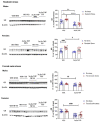
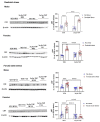
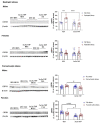
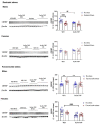
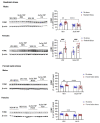
Similar articles
-
The Allopregnanolone Response to Acute Stress in Females: Preclinical and Clinical Studies.Biomolecules. 2022 Sep 8;12(9):1262. doi: 10.3390/biom12091262. Biomolecules. 2022. PMID: 36139100 Free PMC article. Review.
-
Deleterious Interaction between the Neurosteroid (3α,5α)3-Hydroxypregnan-20-One (3α,5α-THP) and the Mu-Opioid System Activation during Forced Swim Stress in Rats.Biomolecules. 2023 Aug 1;13(8):1205. doi: 10.3390/biom13081205. Biomolecules. 2023. PMID: 37627270 Free PMC article.
-
(3α,5α)3-hydroxypregnan-20-one (3α,5α-THP) regulation of hypothalamic and extrahypothalamic corticotropin releasing factor (CRF): Sexual dimorphism and brain region specificity in Sprague Dawley rats.Neuropharmacology. 2021 Mar 15;186:108463. doi: 10.1016/j.neuropharm.2021.108463. Epub 2021 Jan 16. Neuropharmacology. 2021. PMID: 33460689 Free PMC article.
-
Reduction of circulating and selective limbic brain levels of (3α,5α)-3-hydroxy-pregnan-20-one (3α,5α-THP) following forced swim stress in C57BL/6J mice.Psychopharmacology (Berl). 2014 Sep;231(17):3281-92. doi: 10.1007/s00213-014-3552-z. Epub 2014 Apr 18. Psychopharmacology (Berl). 2014. PMID: 24744202 Free PMC article.
-
The Role of HPA Axis and Allopregnanolone on the Neurobiology of Major Depressive Disorders and PTSD.Int J Mol Sci. 2021 May 23;22(11):5495. doi: 10.3390/ijms22115495. Int J Mol Sci. 2021. PMID: 34071053 Free PMC article. Review.
Cited by
-
The role of the hypothalamic-pituitary-adrenal axis in depression across the female reproductive lifecycle: current knowledge and future directions.Front Endocrinol (Lausanne). 2023 Dec 12;14:1295261. doi: 10.3389/fendo.2023.1295261. eCollection 2023. Front Endocrinol (Lausanne). 2023. PMID: 38149098 Free PMC article. Review.
-
The Allopregnanolone Response to Acute Stress in Females: Preclinical and Clinical Studies.Biomolecules. 2022 Sep 8;12(9):1262. doi: 10.3390/biom12091262. Biomolecules. 2022. PMID: 36139100 Free PMC article. Review.
-
Deleterious Interaction between the Neurosteroid (3α,5α)3-Hydroxypregnan-20-One (3α,5α-THP) and the Mu-Opioid System Activation during Forced Swim Stress in Rats.Biomolecules. 2023 Aug 1;13(8):1205. doi: 10.3390/biom13081205. Biomolecules. 2023. PMID: 37627270 Free PMC article.
-
Stress and gonadal steroid influences on alcohol drinking and withdrawal, with focus on animal models in females.Front Neuroendocrinol. 2023 Oct;71:101094. doi: 10.1016/j.yfrne.2023.101094. Epub 2023 Aug 8. Front Neuroendocrinol. 2023. PMID: 37558184 Free PMC article. Review.
-
Acute, but not repeated, cocaine exposure alters allopregnanolone levels in the midbrain of male and female rats.Psychopharmacology (Berl). 2024 May;241(5):1011-1025. doi: 10.1007/s00213-024-06534-8. Epub 2024 Jan 29. Psychopharmacology (Berl). 2024. PMID: 38282126 Free PMC article.
References
-
- Owens M.J., Nemeroff C.B. Physiology and pharmacology of corticotropin-releasing factor. Pharmacol. Rev. 1991;43:425–473. - PubMed
Publication types
MeSH terms
Substances
Grants and funding
LinkOut - more resources
Full Text Sources
Miscellaneous

